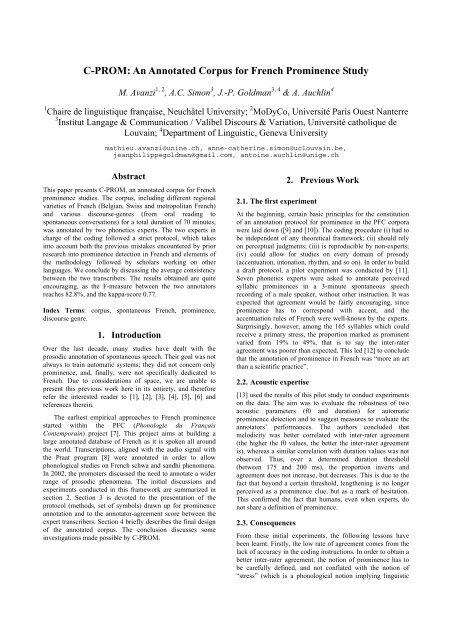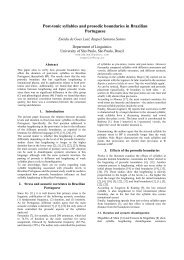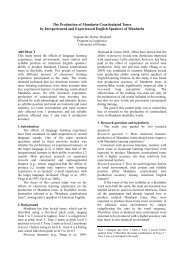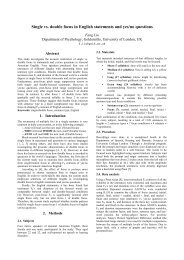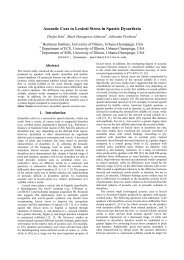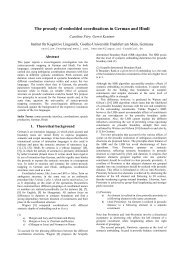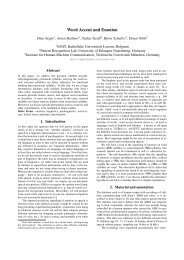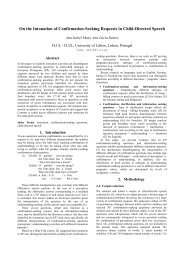C-PROM: An Annotated Corpus for French Prominence ... - GBIF.ch
C-PROM: An Annotated Corpus for French Prominence ... - GBIF.ch
C-PROM: An Annotated Corpus for French Prominence ... - GBIF.ch
You also want an ePaper? Increase the reach of your titles
YUMPU automatically turns print PDFs into web optimized ePapers that Google loves.
C-<strong>PROM</strong>: <strong>An</strong> <strong>An</strong>notated <strong>Corpus</strong> <strong>for</strong> <strong>Fren<strong>ch</strong></strong> <strong>Prominence</strong> Study<br />
M. Avanzi 1, 2 , A.C. Simon 3 , J.-P. Goldman 3, 4 & A. Au<strong>ch</strong>lin 4<br />
1 Chaire de linguistique française, Neu<strong>ch</strong>âtel University; 2 MoDyCo, Université Paris Ouest Nanterre<br />
3 Institut Langage & Communication / Valibel Discours & Variation, Université catholique de<br />
Louvain; 4 Department of Linguistic, Geneva University<br />
mathieu.avanzi@unine.<strong>ch</strong>, anne-catherine.simon@uclouvain.be,<br />
jeanphilippegoldman@gmail.com, antoine.au<strong>ch</strong>lin@unige.<strong>ch</strong><br />
Abstract<br />
This paper presents C-<strong>PROM</strong>, an annotated corpus <strong>for</strong> <strong>Fren<strong>ch</strong></strong><br />
prominence studies. The corpus, including different regional<br />
varieties of <strong>Fren<strong>ch</strong></strong> (Belgian, Swiss and metropolitan <strong>Fren<strong>ch</strong></strong>)<br />
and various discourse-genres (from oral reading to<br />
spontaneous conversations) <strong>for</strong> a total duration of 70 minutes,<br />
was annotated by two phonetics experts. The two experts in<br />
<strong>ch</strong>arge of the coding followed a strict protocol, whi<strong>ch</strong> takes<br />
into account both the previous mistakes encountered by prior<br />
resear<strong>ch</strong> into prominence detection in <strong>Fren<strong>ch</strong></strong> and elements of<br />
the methodology followed by s<strong>ch</strong>olars working on other<br />
languages. We conclude by discussing the average consistency<br />
between the two transcribers. The results obtained are quite<br />
encouraging, as the F-measure between the two annotators<br />
rea<strong>ch</strong>es 82.8%, and the kappa-score 0.77.<br />
Index Terms: corpus, spontaneous <strong>Fren<strong>ch</strong></strong>, prominence,<br />
discourse genre.<br />
1. Introduction<br />
Over the last decade, many studies have dealt with the<br />
prosodic annotation of spontaneous spee<strong>ch</strong>. Their goal was not<br />
always to train automatic systems; they did not concern only<br />
prominence, and, finally, were not specifically dedicated to<br />
<strong>Fren<strong>ch</strong></strong>. Due to considerations of space, we are unable to<br />
present this previous work here in its entirety, and there<strong>for</strong>e<br />
refer the interested reader to [1], [2], [3], [4], [5], [6] and<br />
references therein.<br />
The earliest empirical approa<strong>ch</strong>es to <strong>Fren<strong>ch</strong></strong> prominence<br />
started within the PFC (Phonologie du Français<br />
Contemporain) project [7]. This project aims at building a<br />
large annotated database of <strong>Fren<strong>ch</strong></strong> as it is spoken all around<br />
the world. Transcriptions, aligned with the audio signal with<br />
the Praat program [8] were annotated in order to allow<br />
phonological studies on <strong>Fren<strong>ch</strong></strong> s<strong>ch</strong>wa and sandhi phenomena.<br />
In 2002, the promoters discussed the need to annotate a wider<br />
range of prosodic phenomena. The initial discussions and<br />
experiments conducted in this framework are summarized in<br />
section 2. Section 3 is devoted to the presentation of the<br />
protocol (methods, set of symbols) drawn up <strong>for</strong> prominence<br />
annotation and to the annotator-agreement score between the<br />
expert transcribers. Section 4 briefly describes the final design<br />
of the annotated corpus. The conclusion discusses some<br />
investigations made possible by C-<strong>PROM</strong>.<br />
2.1. The first experiment<br />
2. Previous Work<br />
At the beginning, certain basic principles <strong>for</strong> the constitution<br />
of an annotation protocol <strong>for</strong> prominence in the PFC corpora<br />
were laid down ([9] and [10]). The coding procedure (i) had to<br />
be independent of any theoretical framework; (ii) should rely<br />
on perceptual judgments; (iii) is reproducible by non-experts;<br />
(iv) could allow <strong>for</strong> studies on every domain of prosody<br />
(accentuation, intonation, rhythm, and so on). In order to build<br />
a draft protocol, a pilot experiment was conducted by [11].<br />
Seven phonetics experts were asked to annotate perceived<br />
syllabic prominences in a 3-minute spontaneous spee<strong>ch</strong><br />
recording of a male speaker, without other instruction. It was<br />
expected that agreement would be fairly encouraging, since<br />
prominence has to correspond with accent, and the<br />
accentuation rules of <strong>Fren<strong>ch</strong></strong> were well-known by the experts.<br />
Surprisingly, however, among the 165 syllables whi<strong>ch</strong> could<br />
receive a primary stress, the proportion marked as prominent<br />
varied from 19% to 49%, that is to say the inter-rater<br />
agreement was poorer than expected. This led [12] to conclude<br />
that the annotation of prominence in <strong>Fren<strong>ch</strong></strong> was “more an art<br />
than a scientific practice”.<br />
2.2. Acoustic expertise<br />
[13] used the results of this pilot study to conduct experiments<br />
on the data. The aim was to evaluate the robustness of two<br />
acoustic parameters (f0 and duration) <strong>for</strong> automatic<br />
prominence detection and to suggest measures to evaluate the<br />
annotators’ per<strong>for</strong>mances. The authors concluded that<br />
melodicity was better correlated with inter-rater agreement<br />
(the higher the f0 values, the better the inter-rater agreement<br />
is), whereas a similar correlation with duration values was not<br />
observed. Thus, over a determined duration threshold<br />
(between 175 and 200 ms), the proportion inverts and<br />
agreement does not increase, but decreases. This is due to the<br />
fact that beyond a certain threshold, lengthening is no longer<br />
perceived as a prominence clue, but as a mark of hesitation.<br />
This confirmed the fact that humans, even when experts, do<br />
not share a definition of prominence.<br />
2.3. Consequences<br />
From these initial experiments, the following lessons have<br />
been learnt. Firstly, the low rate of agreement comes from the<br />
lack of accuracy in the coding instructions. In order to obtain a<br />
better inter-rater agreement, the notion of prominence has to<br />
be carefully defined, and not conflated with the notion of<br />
“stress” (whi<strong>ch</strong> is a phonological notion implying linguistic
Figure 1: Praat screen shot of the utterance: “là qui part de nef Chavant là le boulevard qui passé à côté d’Habitat” [mp-1].<br />
<strong>An</strong>notation tiers are, from top to bottom: phones, syllables (both in SAMPA), delivery (H1 and H2 manual annotations), COMPARE<br />
and graphemic words.<br />
knowledge). Secondly, there is a need <strong>for</strong> defining a contextwindow<br />
<strong>for</strong> prominence identification, to avoid ending up with<br />
large parts of the sound signal without any prominence<br />
detection. Furthermore, the above-mentioned authors agreed<br />
that visualization of the signal can be helpful. Finally, the<br />
study of the acoustic correlates of perceived prominences<br />
showed that while f0 was a good cue <strong>for</strong> automatic<br />
identification, so was duration, provided that hesitation marks<br />
had a specific annotation, to avoid biasing the relative duration<br />
calculations.<br />
3. A Methodology <strong>for</strong> Perceptual<br />
<strong>Prominence</strong> <strong>An</strong>notation<br />
These early studies conducted within the PFC project were<br />
undertaken by the authors of the present paper. They led in<br />
fine to the construction of a multi-genre and multi-speaker<br />
corpus, called C-<strong>PROM</strong>, annotated <strong>for</strong> <strong>Fren<strong>ch</strong></strong> prominence<br />
study by two phonetics experts (see Table 3). The C-<strong>PROM</strong><br />
corpus has been developed with the specific purpose of<br />
building an open data-base to train algorithms <strong>for</strong> semiautomatic<br />
prominence detection.<br />
3.1. Data preparation<br />
A 70-minute corpus, sampled <strong>for</strong> different genres (see Table<br />
3), was automatically segmented into phones, syllables and<br />
orthographic words using Praat [8] and the Easyalign script<br />
[14]. All the transcriptions were manually <strong>ch</strong>ecked. Two<br />
annotators (among the authors of this paper) annotated the<br />
whole corpus following the protocol described in the next<br />
section.<br />
3.2. Protocol<br />
The C-<strong>PROM</strong> coding-protocol takes into account the “errors”<br />
encountered in the first PFC studies, and applies some<br />
recommendations made by the supervisors of the spoken<br />
Dut<strong>ch</strong> corpus coding-protocol [3]. In practice, ea<strong>ch</strong> annotator<br />
starts from an empty annotation tier duplicated from the<br />
syllabic tier (the “delivery” tier in Figure 1), and fills every<br />
interval with the symbols described in Table 1. <strong>An</strong>notation in<br />
conducted by listening to a stret<strong>ch</strong> of spee<strong>ch</strong> of 3 to 5 seconds,<br />
no more than three times (over-listening results in overcoding).<br />
As the annotation of prominences relies on auditory<br />
perception of salience and not on the visual analysis of<br />
acoustic parameters (f0 movements, <strong>for</strong> example),<br />
visualization of the signal was restricted to problematic cases.<br />
The first class of symbols is <strong>for</strong> annotating prominent<br />
syllables. Two symbols can be used (p and P). The distinction<br />
between “p” and “P” is heuristic: it <strong>for</strong>ces the transcribers to<br />
develop more accurate listening and avoids marking only the<br />
strongest prominences. It also avoids the use of an indecision<br />
marker su<strong>ch</strong> as “”. During the comparison of the two manual<br />
annotations, these two categories were merged.<br />
Table 1: <strong>An</strong>notation symbols<br />
1. <strong>Prominence</strong> labeling<br />
P strongly prominent syllable<br />
p weakly prominent syllable<br />
non prominent syllable<br />
2. Delivery labeling<br />
z lengthening connected with a hesitation<br />
@ post-tonic syllabic s<strong>ch</strong>wa (as in "c'est dinguE" [sEde~g@])<br />
$ unaccented post-tonic syllables (appendice)<br />
3. Others<br />
% junk (noise, laugh, cough, etc.)<br />
* breath<br />
_<br />
silence<br />
The delivery labeling is used <strong>for</strong> singling out syllables<br />
whi<strong>ch</strong> have specific properties likely to hamper automatic<br />
prominence identification. The “z” symbol is <strong>for</strong> extralengthened<br />
syllables marking hesitation. Their length can<br />
disturb the calculation of relative duration, as shown by [9].<br />
The marking of hesitation also serves to avoid false automatic<br />
detection of prominence. Since hesitations are often followed<br />
by a silent pause, and since silent pause is often considered a<br />
strong clue <strong>for</strong> prominence detection (boundaries and<br />
prominence being merged in <strong>Fren<strong>ch</strong></strong> ([15] and [16]), it could<br />
introduce mistakes in the automatic detection. Post-tonic<br />
s<strong>ch</strong>wa (@) and appendices ($) are considered non prominent,<br />
but they are specifically annotated because they introduce<br />
irregularity in the final-accent system in <strong>Fren<strong>ch</strong></strong>: post-focal<br />
syllables being problematic with regards to f0 [17], the status<br />
of s<strong>ch</strong>wa as a syllabic nucleus is controversial [18]. The<br />
number of symbols in this “delivery” class can also be<br />
explained by the perspective of a semi-automatic<br />
identification of these specific prosodic phenomena. The last<br />
category of symbols is <strong>for</strong> annotating “silence” and the like. It
contains silent pauses (resulting from the semi-automatic<br />
alignment), audible breaths and “junk”, i.e. part of the<br />
recording that could not be transcribed (noise, laughter,<br />
coughing, overlapping, etc.). These could interfere with the<br />
automatic processing of the signal.<br />
3.3. <strong>An</strong>notation task<br />
It took the two transcribers nearly a year to annotate the whole<br />
corpus (the annotation was done between fall 2007 and fall<br />
2008). First, they jointly annotated in a practice session a<br />
small stret<strong>ch</strong> of spee<strong>ch</strong> (a 1-minute long map task). They then<br />
independently annotated the whole corpus, genre by genre.<br />
Ea<strong>ch</strong> time the coding of one sub-corpus (a set of samples from<br />
one genre) had been completed, a comparison tier was<br />
automatically generated. It revealed the full range of<br />
disagreement in coding; the agreed codes were left untou<strong>ch</strong>ed<br />
(see COMPARE-tier in Figure 1). Then the two experts<br />
discussed divergences during a joint session. Due to lack of<br />
space, we cannot address here how the coding divergences<br />
were resolved. See [6] and [19] <strong>for</strong> a systematic analysis of the<br />
inter-transcriber disagreement cases.<br />
3.4. Evaluation of the inter-annotator agreement<br />
The COMPARE-tier was used to estimate the degree of<br />
agreement between the two annotators. Table 2 gives the intertranscriber<br />
agreement <strong>for</strong> ea<strong>ch</strong> recording of the corpus, based<br />
on a count of the intervals involving a conflict between a<br />
“P/p” symbol versus anything else:<br />
Table 2: Inter-annotator consistency: name of the file<br />
(see Table 3), n00/n11: syllables annotated 0 (non<br />
prominent) and p (prominent) by both annotators,<br />
n10/n01: syllables annotated p by one transcriber, 0<br />
by the other; R: recall; P: precision; F: F-measure,<br />
K: Kappa-score<br />
Files n00 n11 n10 n01 R P F K<br />
lec-be 495 87 22 5 94.6 79.8 86.6 0.84<br />
lec-<strong>ch</strong> 390 156 26 33 82.5 85.7 84.1 0.77<br />
lec-fr 469 120 32 2 98.4 78.9 87.6 0.77<br />
pol-be 225 139 21 26 84.2 86.9 85.5 0.76<br />
pol-<strong>ch</strong> 735 162 20 97 62.5 89 73.5 0.66<br />
pol-fr 519 143 13 71 66.8 91.7 77.3 0.70<br />
jpa-be 924 259 58 29 89.9 81.7 85.6 0.81<br />
jpa-<strong>ch</strong> 587 172 29 50 77.5 85.6 81.3 0.75<br />
jpa-fr 668 197 25 46 81.1 88.7 84.7 0.80<br />
cnf-be 727 182 26 84 68.4 87.5 76.8 0.70<br />
cnf-<strong>ch</strong> 586 186 40 59 75.9 82.3 79 0.71<br />
cnf-fr 776 239 39 37 86.6 86 86.3 0.82<br />
int-be 722 224 48 44 83.6 82.4 83 0.77<br />
int-fr 899 262 56 72 78.4 82.4 80.4 0.74<br />
iti-01 124 26 9 2 92.9 74.3 82.5 0.78<br />
iti-02 84 41 1 1 97.6 97.6 97.6 0.96<br />
iti-03 261 83 22 15 84.7 79 81.8 0.75<br />
iti-04 547 154 15 21 88 91.1 89.5 0.86<br />
iti-06 281 87 8 7 92.6 91.6 92.1 0.89<br />
iti-07 94 24 7 1 96 77.4 85.7 0.82<br />
nar-be 582 190 31 36 84.1 86 85 0.80<br />
nar-<strong>ch</strong> 573 172 16 65 72.6 91.5 80.9 0.74<br />
nar-fr 468 149 25 40 78.8 85.6 82.1 0.76<br />
Total 11736 3454 589 843 80.4 85.4 82.8 0.77<br />
The inter-transcriber agreement <strong>for</strong> prominence annotation<br />
was quantified by means of Cohen’s kappa coefficient [20],<br />
and evaluated <strong>for</strong> the whole corpus at 0.77 (the best<br />
per<strong>for</strong>mance is <strong>for</strong> a map task file (0.96 <strong>for</strong> iti-02), the worst<br />
<strong>for</strong> pol-<strong>ch</strong>, with 0.66). The f-measure calculation (harmonic<br />
average between precision and recall [21]) indicates an intertranscriber<br />
agreement of 82.8% (recall: 80.4; precision: 85.4).<br />
Similar to [3], we would like to highlight that su<strong>ch</strong> a good<br />
agreement-score is certainly due to the use of a standard<br />
protocol and joint training. We would there<strong>for</strong>e argue that<br />
these good per<strong>for</strong>mances are strong evidence against the<br />
notion that <strong>Fren<strong>ch</strong></strong> prominence transcription is more an art<br />
than a scientific practice ([12], [16]). Future experiments<br />
involving more transcribers, both experts and non experts,<br />
should allow <strong>for</strong> further confirmation of this fact.<br />
3.5. Reference annotation<br />
A consensual annotation emerged from the discussion on the<br />
COMPARE-tier, and it was considered as a reference<br />
annotation <strong>for</strong> prominence analysis. Table 3 (see next page)<br />
details the composition of the C-<strong>PROM</strong> corpus: it includes 28<br />
speakers (12 females, 16 males) and amounts to 17,778<br />
syllables, from whi<strong>ch</strong> 805 (4.5%) were annotated with a<br />
delivery symbol, 4,570 were annotated as prominent (25.7%)<br />
and 12,403 (69.7%) were non prominent. The corpus is<br />
composed of a set of recordings sampled in seven genres,<br />
ranging from high to low degrees of <strong>for</strong>mality: Read Spee<strong>ch</strong><br />
(LEC), Political Spee<strong>ch</strong>es (POL), Conferences (CNF), News<br />
Broadcasts (JPA), Radio Interviews (INT), Map Tasks (ITI)<br />
and Life Stories (NAR). Except <strong>for</strong> the ITI and INT<br />
recordings, all the discourse genres collections comprise 3-<br />
minute recordings, per<strong>for</strong>med by a native speaker from<br />
Belgium (BE), Switzerland (CH) and metropolitan France<br />
(FR). All the speakers in the corpus speak a highly standard<br />
<strong>Fren<strong>ch</strong></strong>.<br />
4. Conclusion<br />
The aim of this paper was to present the C-<strong>PROM</strong> corpus. We<br />
presented previous work whi<strong>ch</strong> motivated its constitution, and<br />
the methodology followed to build it. Although the<br />
methodology remains to be tested on larger parts of corpora,<br />
including more annotators, this first experiment nevertheless<br />
produced encouraging results. Sub-parts of the corpus have<br />
already been used to train different automatic prominence<br />
detection algorithms ([6], [22], [23], [24]). It also resulted in<br />
studies on the automatic estimation of discourse genres based<br />
on prosodic features ([25], [26]). We finally hope that our<br />
corpus will facilitate comparisons between different studies,<br />
whi<strong>ch</strong> were not previously possible because of the<br />
unavailability of shared data. <strong>An</strong> online version of C-<strong>PROM</strong><br />
with the manual annotation can be downloaded here:<br />
http://sites.google.com/site/corpusprom.<br />
5. Acknowledgments<br />
This resear<strong>ch</strong> was supported by The Swiss National Science<br />
Foundation (grant n° PBNEP1-127788, Neu<strong>ch</strong>âtel University)<br />
and by the Programme Wist2 Convention n°616422, financed<br />
by Région wallonne (Belgique), Projet EXPRESSIVE.<br />
6. References<br />
[1] Pickering, B., Williams, B. & G. Knowles G., “<strong>An</strong>alysis of<br />
Transcriber Differences in the SEC, in Knowles, G. et al. (eds),<br />
Working with Spee<strong>ch</strong>: perspectives on resear<strong>ch</strong> into the<br />
Lancaster/IBM Spoken English <strong>Corpus</strong>. London/New-York:<br />
Longman, 59-105, 1996.<br />
[2] Grabe, E., Post, B., & F. Nolan, “Modelling Intonational<br />
Variation in English: The IViE System”, in Puppel, S. & G.<br />
Demenko (eds), Prosody 2000, Poznan, Adam Mickiewicz<br />
University, 51-58, 2001.<br />
[3] Buhmann, J., Caspers, J., van Heuven, V, Hoekstra, H., Martens,<br />
J.-P. & M. Swerts, “<strong>An</strong>notation of Prominent Words, Prosodic<br />
Boundaries and Segmental Lengthening by Non Expert
Transcribers in the Spoken Dut<strong>ch</strong> <strong>Corpus</strong>”, LREC Processing,<br />
779-785, 2002.<br />
[4] Tamburini, F. & C. Caini, “<strong>An</strong> Automatic System <strong>for</strong> Detecting<br />
Prosodic <strong>Prominence</strong> in American English Continuous Spee<strong>ch</strong>”,<br />
International Journal of Spee<strong>ch</strong> Te<strong>ch</strong>nology, 8, 33-44, 2005.<br />
[5] Rosenberg, A & J. Hirs<strong>ch</strong>berg, “Detecting pit<strong>ch</strong> accent using<br />
pit<strong>ch</strong> corrected energy-based predictors,” Interspee<strong>ch</strong>’07, 2777–<br />
2780, 2007.<br />
[6] Avanzi, M., Goldman, J.-P. La<strong>ch</strong>eret-Dujour, A. Simon, A.-C. &<br />
A. Au<strong>ch</strong>lin, “Méthodologie et algorithmes pour la détection<br />
automatique des syllabes proéminentes dans les corpus de<br />
français parlé”, Cahiers of <strong>Fren<strong>ch</strong></strong> Language Studies, vol. 13, no.<br />
2, pp. 2–30, 2007.<br />
[7] Durand, J., Laks, B. & C. Ly<strong>ch</strong>e. “La phonologie du français<br />
contemporain: usages, variétés et structure”, in Pus<strong>ch</strong>, C. & W.<br />
Raible (eds.), Romance <strong>Corpus</strong> Linguistics - Corpora and<br />
Spoken Language, Tübigen, Gunter Narr Verlag, 93-106, 2002.<br />
[8] Boersma, P. & Weenink, D. Praat: doing phonetics by computer<br />
(Version 5.1). www.praat.org, 2010.<br />
[9] La<strong>ch</strong>eret-Dujour, A., Ly<strong>ch</strong>e, Ch. & M. Morel, “Pour une<br />
transcription prosodique normalisée au sein du projet PFC<br />
(phonologie du français contemporain): <strong>ch</strong>amp d’action et<br />
limites”, Actes des 25 èmes journées d’étude sur la parole, Fès,<br />
Maroc, 2004.<br />
[10] Poiré, F., “La codification de la prosodie”, Bulletin PFC, 4, 89-<br />
98, 2005.<br />
[11] Poiré, P. “La perception des proéminences et le codage<br />
prosodique”, Bulletin PFC, 6, 69-79, 2006.<br />
[12] Martin, Ph. « La transcription des proéminences accentuelles :<br />
mission impossible », Bulletin PFC, 6, 81-87, 2006.<br />
[13] Morel M., La<strong>ch</strong>eret-Dujour, A. Ly<strong>ch</strong>e, Ch., Poiré, F. “Vous avez<br />
dit proéminence”, Actes des 26 èmes journées d’étude sur la<br />
parole, Dinar, Maroc, 2006.<br />
[14] Goldman, J.-P. “EasyAlign: a semi-automatic phonetic alignment<br />
tool under Praat”, http://latlcui.unige.<strong>ch</strong>/phonetique, 2008.<br />
[15] Rossi, M. “Le français, langue sans accent ”, Studia Phonetica,<br />
13-51, 1979.<br />
[16] Vaissière, J. “Rhythm, accentuation and final lenghtening in<br />
<strong>Fren<strong>ch</strong></strong>”, in Sundberg et al. (eds), Music, Language Spee<strong>ch</strong> and<br />
Brain, Macmillan Press, 108-120, 1991.<br />
[17] Mertens, P. “A Predictive Approa<strong>ch</strong> to the <strong>An</strong>alysis of Intonation<br />
in Discourse in <strong>Fren<strong>ch</strong></strong>”, in Kawagu<strong>ch</strong>i, Y. et al. (eds), Prosody<br />
and Syntax. Amsterdam: Benjamins, 64-101, 2006.<br />
[18] Dell, F. Generative Phonology and <strong>Fren<strong>ch</strong></strong> Phonology,<br />
Cambridge, Cambridge University Press, 1980.<br />
[19] Goldman, J.-P. et al. “<strong>Prominence</strong> perception and accent<br />
detection in <strong>Fren<strong>ch</strong></strong>. A corpus-based account”, Paper submitted<br />
to Spee<strong>ch</strong> Prosody 2010.<br />
[20] Cohen, J., “A coefficient of agreement <strong>for</strong> nominal scales”,<br />
Educational and Psy<strong>ch</strong>ological Measurement, 20:37-46, 1960.<br />
[21] van Rijsbergen, C.J. In<strong>for</strong>mation Retrieval, Butterworths,<br />
London, 1979.<br />
[22] Goldman, J.-P.; Avanzi, M.; La<strong>ch</strong>eret-Dujour, A.; Simon, A.-C.;<br />
Au<strong>ch</strong>lin, A.. A Methodology <strong>for</strong> the Automatic Detection of<br />
Perceived Prominent Syllables in Spoken <strong>Fren<strong>ch</strong></strong>. In Proceedings<br />
of Interspee<strong>ch</strong>’07, <strong>An</strong>twerp, Belgium, August 27-31. 98-101,<br />
2007.<br />
[23] Avanzi, M. La<strong>ch</strong>eret-Dujour, A. & Victorri, B. “ANALOR. A<br />
Tool <strong>for</strong> Semi-Automatic <strong>An</strong>notation of <strong>Fren<strong>ch</strong></strong> Prosodic<br />
Structure”, Proceedings of Spee<strong>ch</strong> Prosody’08, 119-122, 2008.<br />
[24] Obin, N., Goldman, J.-P., Avanzi, M. & La<strong>ch</strong>eret-Dujour, A.<br />
« Comparaison de trois outils de détection semi-automatique des<br />
proéminences dans les corpus de français parlé », Actes des<br />
22 èmes JEP, Avignon, 2008.<br />
[25] Obin, N., La<strong>ch</strong>eret-Dujour, A., Veaux, C., Rodet, X & A.C.<br />
Simon, “A Method <strong>for</strong> Automatic and Dynamic Estimation of<br />
Discourse Genre Typology with Prosodic Features”, Interspee<strong>ch</strong>,<br />
Brisbane, 2008.<br />
[26] Simon, A.C., Au<strong>ch</strong>lin, A., Avanzi, M. & Goldman, J.-P. “Les<br />
phonostyles. Une description prosodique des styles de parole en<br />
français”, Actes du colloque Les voix du français : usages<br />
et représentations, Ox<strong>for</strong>d, 2008.<br />
Table 3. C-Prom design. With, from left to right: discourse genre, sub-corpus code, speaker (male or female), duration,<br />
syllables, Non-Prominent Syllables, Prominent Syllables, Delivery syllables as elongations (Z), post-focus syllables ($) and<br />
post-tonic s<strong>ch</strong>was (@). Sub-totals are in bold. Total of the whole corpus is given in the last grey line of the table.<br />
+<strong>for</strong>mal<br />
- <strong>for</strong>mal<br />
Genres Files Speakers<br />
Duration Total. Non-prom Prom<br />
Delivery syllables<br />
(sec.) syllables syllables syllables total Z $ @<br />
LEC-BE M 114 606 492 111 3 0 0 3<br />
Read Spee<strong>ch</strong> LEC-CH M 137 606 403 196 7 0 0 7<br />
LEC-FR M 150 618 462 153 3 0 0 3<br />
total 3M 401 1830 1357 460 13 0 0 13<br />
POL-BE M 188 420 246 160 14 0 0 14<br />
Political POL-CH F 230 1011 753 257 1 0 0 1<br />
Spee<strong>ch</strong> POL-FR M 217 743 533 209 1 1 0 0<br />
News<br />
Broadcast<br />
Conference<br />
Radio<br />
Interview<br />
Map<br />
Task<br />
Life<br />
Story<br />
total 2M/1F 635 2174 1532 626 16 1 0 15<br />
JPA-BE M 253 1315 963 312 40 24 0 16<br />
JPA-CH F 180 879 610 242 27 12 0 15<br />
JPA-FR M 188 971 683 256 32 19 0 13<br />
total 2M/1F 621 3165 2256 810 99 55 0 44<br />
CNF-BE F 244 1066 776 250 40 35 0 5<br />
CNF-CH M 219 950 627 260 63 55 7 1<br />
CNF-FR F 224 1117 798 301 18 12 1 5<br />
total 1M/2F 687 3133 2201 811 121 102 8 11<br />
INT-BE 2F 296 1189 769 317 103 56 32 15<br />
INT-FR 2M 331 1402 996 346 60 21 30 9<br />
total 2M/2F 627 2591 1765 663 163 77 62 24<br />
ITI-01 M 50 172 117 36 19 15 2 2<br />
ITI-02 2M 47 142 82 42 18 17 1 0<br />
ITI-03 F 100 419 270 104 45 30 11 4<br />
ITI-04 2F 204 790 538 197 55 50 1 4<br />
ITI-05 M 28 128 92 27 9 8 0 1<br />
ITI-06 1M/1F 128 431 298 106 27 17 8 2<br />
ITI-07 M 33 140 98 30 12 10 2 0<br />
total 6M/3F 590 2222 1495 542 185 147 25 13<br />
NAR-BE F 206 939 634 238 67 55 12 0<br />
NAR-CH F 218 949 632 228 89 75 8 6<br />
NAR-FR F 198 775 531 192 52 46 2 4<br />
total 3F 622 2663 1797 658 208 176 22 10<br />
7 genres 24 16M/12F 4183 17778 12403 4570 805 558 117 130


